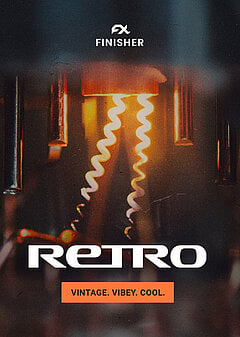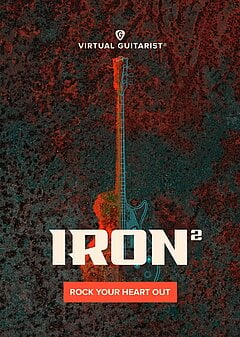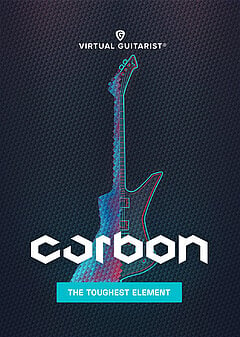How To Bring Back The Golden Era Of Analog Gear Pt. 2
In part 2, Eli Krantzberg looks back at the recording aesthetics of the 80s and 90s. Finisher RETRO covers these decades, each with its own set of customized macros and enough variations to make the presets flexible and unique sounding.
APRIL 11TH, 2021
by Eli Krantzberg
Nostalgia is a funny thing. Those who were old enough to have lived through the era have very different memories and associations than those experiencing the period vicariously through various recreations. Take the 1980s, for example. For me, it was the era of fanny packs, MTV, VCRs, Lady Dianna becoming a modern fairy tale princess, Ronald Reagan, mixtapes, aerobics workouts, Mr.T, and Ferris Bueller. Those are a few of the random cultural associations that come to mind.
The 1980s
The music industry, both technically and creatively, was full of era-defining aspects and qualities as well. It was the time of metal hair bands like Bon Jovi, Motley Crüe, Def Leppard, and Van Halen. But the eighties also brought us Michael Jackson, Culture Club, Madonna, and a new era of synth and drum machine-driven pop music. Like the 70s, live musicians, real instruments, and heavy tape machines were still the foundation of music creation. We saw the arrival of Atari and Macintosh computers along with early sequencing software. The electronic sounds blended nicely with live musicians, still recording in big studios.
Consoles got bigger, and tape got thicker. Most decent recording studios were built around either a Harrison 32C and SSL mixing board. The Harrison EQs and SSL bus compression became defining processing effects of the era. External effects processing also entered a new period with hardware like the Eventide H3000 Factory, Tube Tech EQs, and a whole new generation of modulation-based guitar effects pedals chained together. Gated reverb, and processed drums, along with strictly quantized DMX and Linn drum machines, were the new drum sound. The Roland D-50 and Yamaha DX-7, along with 12 bit Akai S-9000 samplers, were the decade's defining synth sounds.
Zeitgeist
How can we possibly recreate all of these various aesthetic human and technological components contributing to a generation's sound? We can't go back in time. No amount of plug-ins and vintage hardware will recreate the past. We can, however, summon the zeitgeist of the era – which is a much more manageable task than attempting to recreate it.
In the first part of this article, I looked at using Finisher RETRO to capture the 60s and 70s recording aesthetics. Through a series of cleverly programmed macros, UJAM put together the essential elements needed to summon the era's sounds. The good news is, Finisher RETRO does not leave us hanging at the end of the 1970s. The '80s and '90s are covered, each with its own set of customized macros. Each with enough variations to make the presets flexible and unique sounding.
Drums
In this example, I've got a typical '80s sounding drum machine-style drum groove. It sounds fine on its own. But I've run it through a couple of Finisher RETRO instances, set up in series, to add a taste of the type of processed drum sounds we heard back then. The Dimensional Chorus preset adds some chorus – not something typically associated with drum mixing. It sounds to me like a complex modulation chain built around the old Roland Dimension D hardware unit. The first variation set to Off and a relatively modest amount of the Finisher knob dialled in adds a stereo widening that screams the '80s. After this, I've set up some console emulation on the second instance of Finisher. The subtle saturation added is characteristic of the mixing boards of the era.
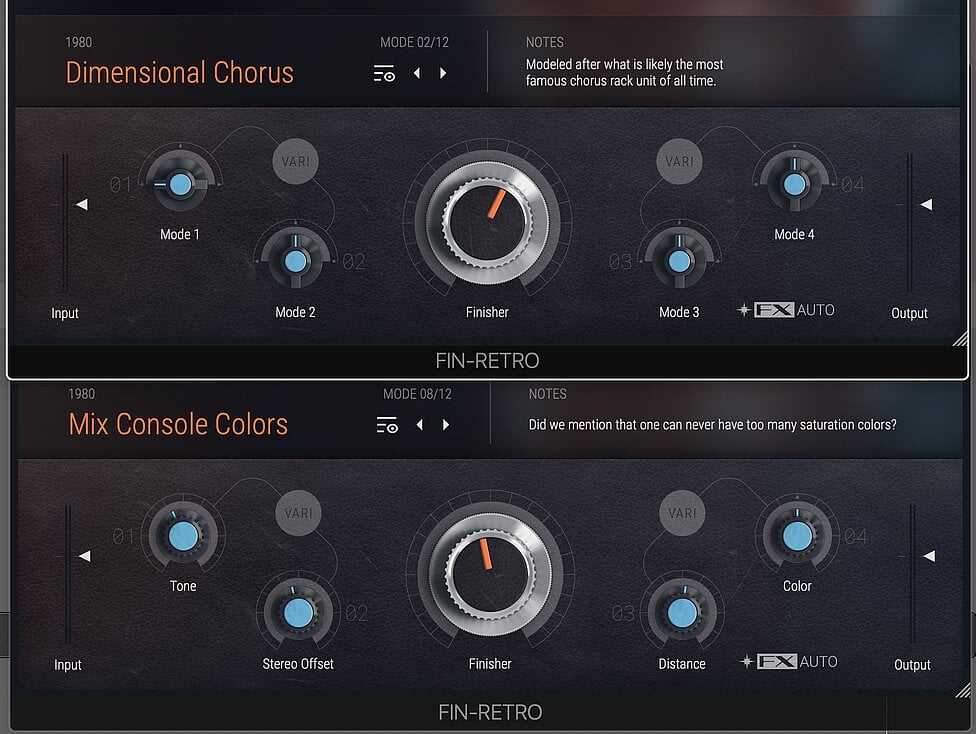
Four bars of unprocessed drums, followed by four bars with two instances of Finisher RETRO, adding subtle modulation and console saturation.
Bass
Synth bass was de rigeur in the ’80s. Here I’ve sequenced up a simple part in the era’s style and layered several synth basses together, emphasizing different aspects of the note envelopes and overall texture. An FM synth enforces each note’s attack; an analog bass fleshes out the sustain, a Juno Bass adds some texture, and so on. Here I’ve also used two instances of Finisher RETRO in series. The first captures the spirit of the early digital delays, complete with tonal filtering and low-resolution repeats. The second adds subtle cassette tape saturation, standard with the four-track Porta Studios of the era.
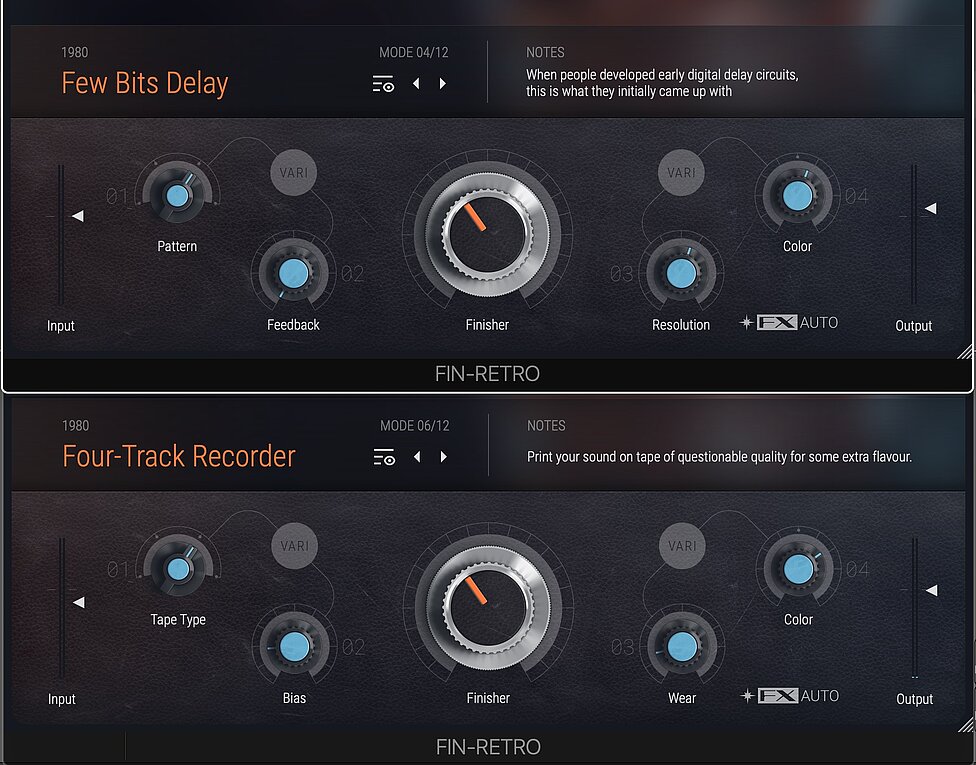
Four bars of layered synth bass, followed by the same part with Finisher RETRO digital delay and four-track cassette tape saturation.
Keys and Guitar
Analog synth brass sounds were ubiquitous in the ’80s. The iconic intro to Van Halen’s Jump being the classic example. Here I’ve got some sustained chords with two patches layered together (from Omnisphere and Flacon). Finisher RETRO. Dimension Chorus. With all the variations dialled up full to “bright” settings. It doesn’t need anything else.
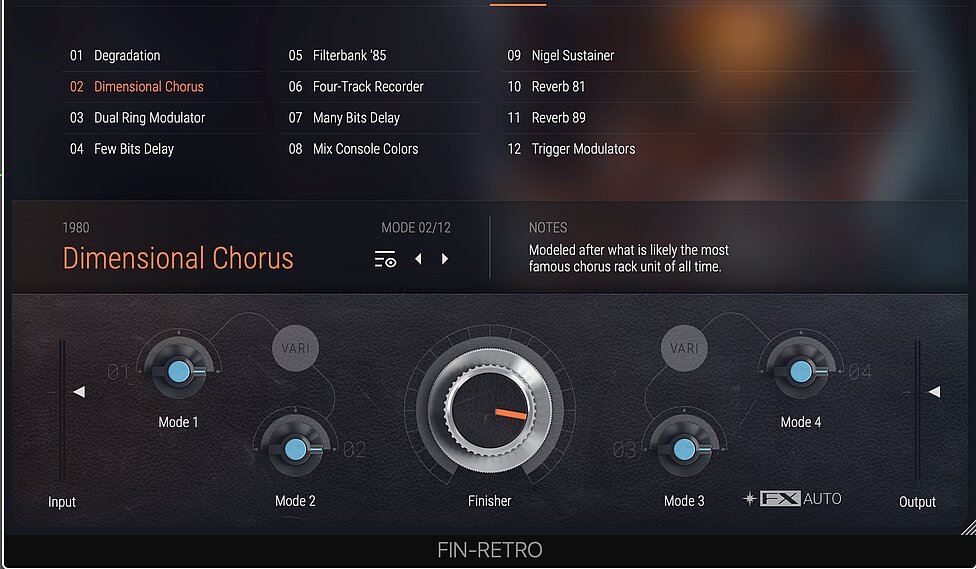
Four bars of synth brass with no effects, then with the Finisher RETRO Dimensional Chorus preset with all variations dialled up to “bright” mode.
I used Virtual Guitarist CARBON to program a simple melody-like line on top. Two instances of Finisher RETRO add life to it. The first, with the Nigel Sustainer preset, adds some harsh ’80s style bit to the tone. The second adds some lo-fi 80’s digital reverb to help soften and round out the sharp edges.
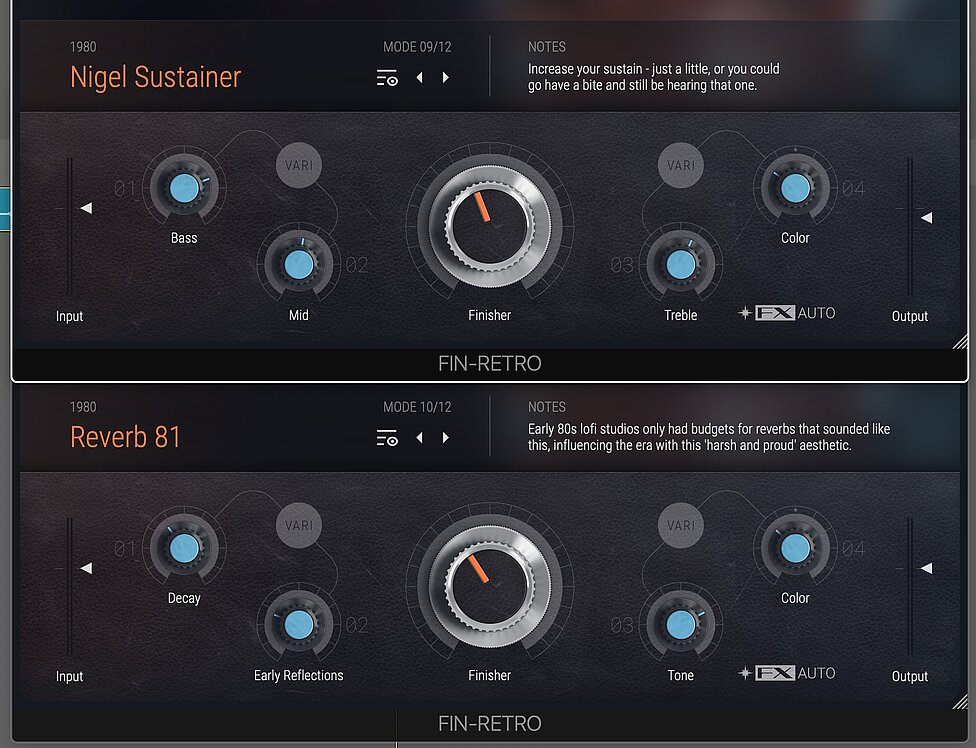
Four bars of Virtual Guitarist CARBON unprocessed, followed by four bars with Finisher RETRO adding some sustain and lo-fi digital reverb.
Finally, here is the whole mix without and then with all instances of Finisher RETRO added.
05-Full-Mix-Dry-Then-Wet.mp3
The whole arrangement with no Finisher RETRO, then with all instances enabled.
The ‘90s
Home recording grew in affordability. Digital audio recording within Pro Tools, Logic, and the like was born, but still relatively niche. It was still most common to trigger external MIDI devices and record audio to tape. If you were lucky, that would be ADAT digital tape. CDs replaced cassette tapes. 16-bit audio was the norm, with 24-bit recording still only a distant glimmer in audio interface developer’s eyes.
For those of you old enough to remember the 1990s, these words will evoke nostalgia, recent and real enough to be remembered accurately: ADAT, DAWs, Pro Tools, Emu Proteus, Roland & Korg synths and modules, Line 6 guitar pods, Mackie CR1604 mixing boards, Gigasampler, CDs, TC Electronics Finalizer, Yamaha O2R Digital consoles, MIDI sync devices, Boss DR-600 drum machine, mastering & loudness wars. Enough said. Finisher RETRO has got you covered for this era as well.
’90s Drums
It was the early days of techno. Think TR 909, Madonna Vogue. Strike a pose; there’s nothing to it. Here is a typical 909 style groove. It sounds fine on its own, but the Multibandman Finisher RETRO setting brings it to life with fine-tuned distortion blended into the compressed signal.
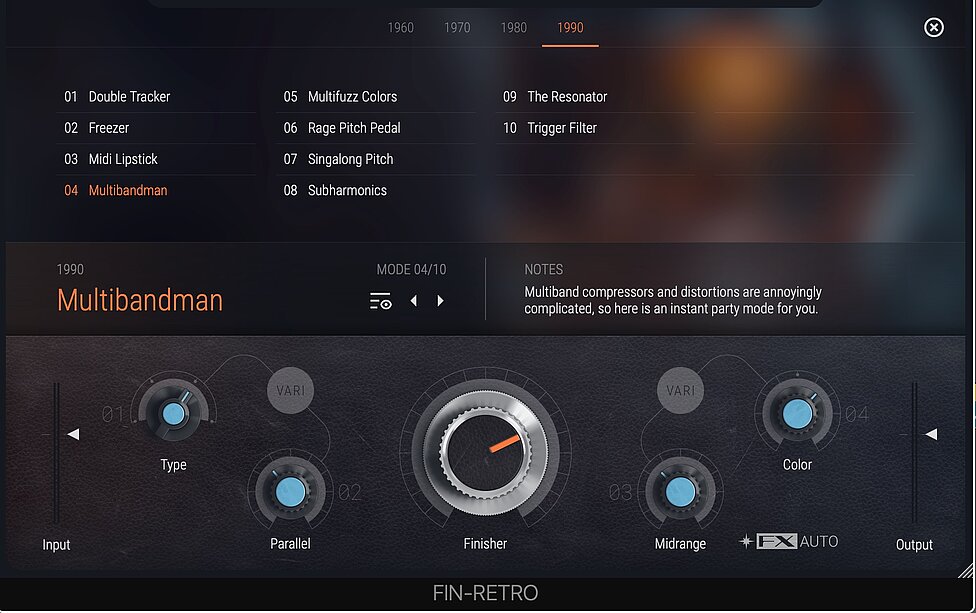
4 bars of 909 drums followed by 4 bars with parallel multiband distortion/compression, courtesy of Finisher RETRO.
Bass Send-Return
I layered some synth bass sounds again. I used two instances of Finisher RETRO for processing. This time, for more of a ’90s approach and feel, I set the second up on an FX return channel strip and dialled it up to blend it in parallel with the main track. They are both adding weight and bottom end to fatten up the overall tone. The first uses a preset called trigger Finger. The attack and release knob trajectories are not what one would expect from knobs with these labels. I set them to taste by ear. The second instance, on the return channel, again adds weight. It is a bit over the top on its own but is easy to control set up like this in parallel.
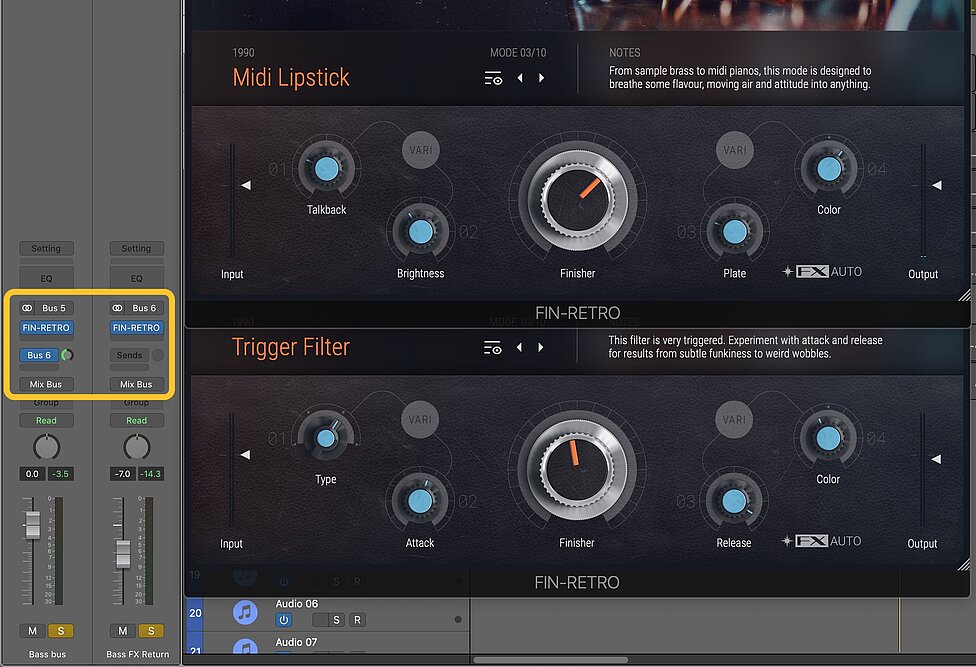
4 bars of bass dry followed by 4 bars with Finisher RETRO used as a channel insert and on an FX Return channel.
Synth Stabs & Guitar
I set up some layered rhythmic synth chord style stabs that sound okay, but wow, did Finisher RETRO ever breathe life into them with its mysterious “The Resonator” preset. I’m not sure exactly what this setting does, but there is some stereo image sweetening, reverb, and more.
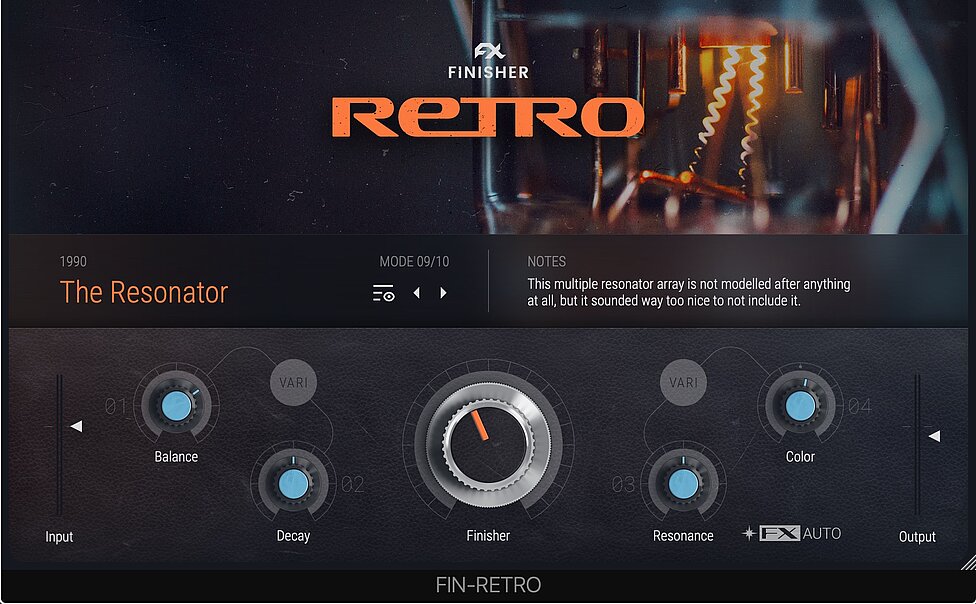
4 bars of dry synth stabs followed by 4 bars with the mysterious “The Resonator” setting in Finisher RETRO.
Virtual Guitarist IRON provided the guitar with two instances of Finisher RETRO in series. The first supplies parallel multiband distortion and compression. The second is an envelope follower filter. Automated, it adds just the right amount of tonal colouration to the sound without sounding like an old wah pedal.
The automated Finisher knob provides envelope filtering without sounding like a wah pedal.
Finally, here is the whole mix, with some synth arpeggios added to the top end. First is the unprocessed version. Then with all instances of Finisher RETRO.
The whole mix without any additional processing followed by all instances of Finisher RETRO enabled.
So although we can’t recreate the past, we can, at least, figuratively conjure its mysteries and sounds. All thanks to the witches’ brew of secret recipes, that is, Finisher RETRO.
Stay up to date
Sign up and we’ll send you an e-mail with product news and helpful stuff every now and then. You may unsubscribe at any time.
Defy Limits
We develop software solutions that enable people to create, consume and interact with music.
